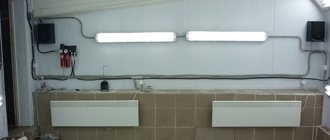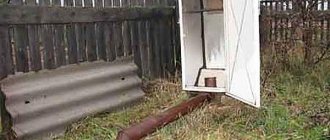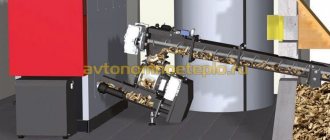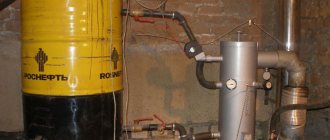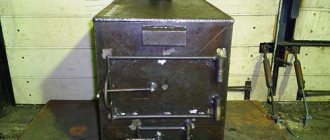Author: Yuriy Fedorovich Kolesnikov, thermal power engineer
A potbelly stove is perhaps the simplest type of household heating and cooking stoves. And, probably, the cheapest and easiest to use. There are many types of potbelly stoves on sale - from a purely utilitarian appearance to retro in artistic design and modern high-tech ones created using composites and nanomaterials, see fig.
The purpose of this article is, firstly, to help the reader understand all this diversity. Taking advantage of the popularity of the people's brand, advertisers and marketers call them potbelly stoves. You can even come across names like “potbelly stove-buleryan”. One has to think that soon they will start offering salted sugar, dried watermelons or arctic-tropical resorts...
Secondly, to help those who want to make a potbelly stove with their own hands. A potbelly stove is not a collective name for something technically amorphous, but a structure created for a specific purpose in compliance with clear principles.
Thirdly, to debunk some prejudices regarding potbelly stoves. It is believed that they are gluttonous, like a greedy bourgeois, picky about fuel, like a gourmet about the menu in an expensive restaurant, and are fire and injury hazards. Meanwhile, the potbelly stove was born in conditions requiring exactly the opposite qualities. And it was not created by stupid amateurs...
Pedigree with history
The potbelly stove was invented by the bourgeoisie who had not been beaten by the revolution; in the terminology of the victorious proletariat - “former”. Just not speculators-exploiters. Even during the years of Stolypin’s rise before the World War, they transferred capital to the then offshore companies, and when Brusilov’s breakthrough (“Cossacks are five steps from Berlin!”), with the gentle but strong assistance of the agents of the Tsarina and Grishka Rasputin, choked, they rushed en masse to Paris, London, Brooklyn.
The remaining “formers” were, for the most part, highly qualified specialists in various industries and deeply decent people. For this, the proletarians commended them no more than Polygraph Poligraphych Sharikov commended Professor Preobrazhensky. They used it, but under war communism, food and fuel were allocated only according to a mandate signed personally by Lenin.
Fortunately, students and younger colleagues of suitable origin did not let the “former” die. In the film about A. N. Tupolev there is a very truthful episode: the future great aircraft designer, and then still a student, sawing for firewood with another future great aviator - N. N. Polikarpov - in the apartment of the father of aerodynamics N. E Zhukovsky, a tree stolen in the park , and immediately the potbelly stove bursts with heat.
But the potbelly stove was not invented by aviators, but by heating engineers. Russia has long been famous for its stove making. The foreigners who visited it, as one, admired the perfection of Russian stoves, Olearius and Casanova, and climbed into them to examine the device. Casanova writes in his memoirs: “The skill of the Russians in constructing stoves surpasses the skill of the Venetians in constructing artificial reservoirs.” Coming from a Venetian, this is extraordinary praise.
From here it immediately becomes clear that the gluttony of potbelly stoves is simply a consequence of improper design and/or operation. You can’t just steal a tree or a fence; the Cheka doesn’t sleep until they are shot on the spot. The stove had to be created so that the Viennese set would last at least for the winter. And the “former” ones knew a lot about heat engineering and other sciences necessary for the furnace business.
Modern potbelly stove in artistic design
With the beginning of the NEP and the rise of the USSR, the attitude towards the “former”, at least at the top, changed radically. But the potbelly stove did not disappear as unnecessary. Even under Lenin, workers began to be given plots of land in the suburbs for what they called then suburban vegetable gardens. Which are nothing more than the current dachas. And the potbelly stove, economical, simply simple and unpretentious, was just right for the dacha. In what capacity is it most used today?
It was then that the industrial production of potbelly stoves began. True, not for the working class, but for the defenders of the revolution - the Red Army. At the same time, its design was brought to complete perfection, and turned out to be so successful that artistically designed potbelly stoves were exported in large quantities, delivering foreign currency to the USSR, bypassing the sanctions of that time.
Far from the homeland, the potbelly stove did not go unnoticed by the local bourgeoisie. The Finns were the first to begin its industrial production abroad, back in the 20s. And now Canadian, Swedish, Finnish stoves are holding confidently on the stove market, see fig. on right. First of all, thanks to the very moderate, compared to comparable stoves of other designs, price and ease of use.
About price and quality
Here it would be appropriate to immediately raise the question: what is better – buy or build? Let's say right away - decide for yourself, depending on the available funds, skills and abilities for technical creativity. The costs of building your own potbelly stove are unlikely to be less than buying a ready-made one . But in a potbelly stove it is easier to implement and test new stove ideas.
Potbelly stove “Gnome”
For example, shown in Fig. The simplest “Gnome” stove costs about 6,000 rubles. And shown in Fig. higher - already 20-25 thousand rubles. And it's worth it if it's used as a fireplace; There will be a special section about this later.
If you have enough money to buy a stove, then it is better to buy a cast iron one. In terms of its qualities, a cast iron potbelly stove is preferable to all others. “Military” potbelly stoves, which will also be discussed separately, are mostly cast iron. Those wishing to acquire a potbelly stove should also pay close attention to online auctions and stove sites with sales. The fact is that there you can find cast iron stoves no more expensive than the simplest welded new ones, see fig. below. For a clearly antique-looking stove in perfect condition, they are asking, accordingly, up to 100,000 rubles. and more, but the “cast iron” is rusty, but with artistic casting and a two-burner hob “pulls” 7-8 thousand.
Cast iron stoves
Design and operating principle
Now let us explain to those who want to make a potbelly stove why it is good. The structure of the, so to speak, primordial potbelly stove is shown schematically in the following. rice. on right. It looks like a primitive stove with a solid hearth, with an efficiency of 5-10%, but the “former” ones needed to achieve an efficiency of up to 60% or more, while maintaining the simplicity of the design (everything is in ruins, you can’t find a nail). A lower value could cost one’s life if heated with Viennese units. How did the bourgeois achieve this?
Diagram of the simplest potbelly stove
Pipe
The first highlight of the potbelly stove is the pipe. More precisely, its diameter. The throughput of the chimney must be less than the flue gas capacity of the furnace. Then they will not be able to immediately go into the chimney, and will make several revolutions inside the firebox in a vertical plane, at the same time sucking in the air necessary for complete combustion of the fuel. The gases will squeeze into the chimney when they have cooled down enough.
The required gas distribution is ensured by an accurate calculation of the pipe diameter. It should be (in millimeters) 2.7 times the volume of the firebox, counting it in liters. For example, the “Gnome” shown above has a firebox volume of about 40 liters. Then the optimal pipe diameter is 106 mm. In the actual design – 110, which indicates that it was well thought out.
If the potbelly stove has grates and horizontal smoke channels, see below, then the height of the firebox is calculated from the top of the grate to the bottom of the partition of the first channel. The diameter of the chimney can be taken within the range of 2.5-3 firebox volumes to fit within the standard range of sizes; The ratio is the same, millimeters-liters. For reference: 2.7 is the rounded value of the base of the natural logarithm e = 2.718281828...
Screen
Hot gases simply swirling around in an iron box will cool too quickly. And they should not just cool down, but burn out. And the fuel must burn in partial pyrolysis mode, which also requires high temperature. The most economical complete pyrolysis of Viennese furniture, dry as gunpowder, cannot be achieved. Sometimes you manage to get hold of coal, but it is not suitable for pyrolysis, so the stove itself must smoothly transition from mode to mode and also work on smoldering.
Hence the second secret of the potbelly stove: a metal screen on three sides, on the sides and on the back. That is, the screen covers half the surface area of the stove. Half of this was also not taken at random, but as a result of complex calculations and precise calculations.
The screen should be 50-70 mm away from the body of the stove. At the same time, it will reflect back more than half of the IR radiation onto it. This will give just the right temperature inside the firebox, and at the same time reduce the risk of burns or fire. In addition, the gap between the screen and the body of the stove is necessary to further increase its efficiency at the beginning of the fire, see below.
Convection
High-energy fuel (dry wood, coal) releases a lot of heat at the beginning of combustion. Even if you heat the stove little by little, it will fly out into the chimney, which is not necessary for the “ex” who is freezing in a beaver coat. Moreover, there is a limited supply of fuel, and the possibility of regularly replenishing it is very problematic. Hence, you need to somehow very quickly transfer the initial flash of heat into the room.
Physically, there is a way: the fastest heat transfer mechanism is convection. You just need to not let the outside air near the stove immediately “scatter to the sides,” but hold it near the hot surface and let it flow across it casually. Which is what the screen does. So its distance of 50-70 mm from the body is also not out of the blue. Anyone who understands aerodynamics, estimate whether the Reynolds number will go beyond laminarity under normal conditions? Hence it is clear that there is no point in enclosing horizontal surfaces with a screen, and the front surface is still very weakly heated and will not increase convection, only extra material is needed and it will be inconvenient to use the stove.
Litter
Under the stove it is moderately heated compared to the walls, but still intensely emits IR downwards. This does not impair the efficiency of the stove, but it is not far from a fire when installed on a wooden floor. Therefore, the installation of a potbelly stove should be carried out on a metal sheet with a distance of at least 350 mm along the contour of the stove (ideally from 600 mm), laid, in turn, on a sheet of asbestos or modern, completely safe for health, material - basalt or kaolin cardboard with a thickness of at least 6 mm. Now this will also increase the efficiency of the potbelly stove: in the days of the “former”, concrete floors were rare.
Chimney
Finally, a potbelly stove is still not a full-fledged pyrolysis stove, and with all the tricks described above, the gases go into the chimney while still very hot and not completely burned out. In order to squeeze out all the heat from them, it was necessary to take the chimney seriously.
A chimney for a potbelly stove is built as follows: first there is a vertical part with a height of at least 1-1.2 m. It is advisable to wrap it with thermal insulation, at least the same basalt cardboard. Then a gas economizer is formed in it, weaker than in the Buleryan stove, but still quite active.
Then - a hog, a horizontal or slightly inclined (plus or minus 10 degrees) pipe of the same diameter. It is in the hog that the remaining flue gases burn out, and it releases up to a quarter of the heat from the stove into the room. The minimum length of a hog is 2.5 m, and 4.5 m or more is best. In bourgeois apartments this was achieved without difficulty, but with the advent of the habit of small-sized housing, the role of the hog was forgotten.
The hog must be at least 1.2 m away from the ceiling and from walls plastered with ordinary, non-heat-resistant plaster. This is explained not only by fire safety requirements: the plaster will soon begin to swell and peel due to variable thermal loads. The hog must be at least 1.5 m away from the wooden wall.
According to injury safety requirements, there must be at least 2.2 m from the bottom of the hog to the floor so that a tall person wearing a hat does not touch his head on a hot pipe. Bourgeois ceilings of 3.5 - 4 m are now also rare, so in modern housing it is advisable to surround the bourgeois with a protective fence in the form of a cylinder made of metal mesh.
Installation Rules
It seems that the question is not relevant; installing a stove at the dacha is not at all difficult. In fact, this is true; you need to follow the installation recommendations in order to protect yourself and your home.
Manufacturers do not prohibit self-installation, but pay attention to some details:
- - if there is a wooden floor, it should be protected with non-combustible material, for example, ceramic tiles. During combustion, a potbelly stove generates a lot of heat, and to avoid damaging the wooden base of the floor, it is recommended to additionally screed or lay down blocks;
- - the potbelly stove can be placed on an asbestos sheet, under which there is a metal one;
- — a minimum distance of 1.5 meters must be maintained from the stove to the wall;
- - the walls next to which the stove is located should be protected with non-combustible material;
- — a few words about the chimney. It requires special attention. First of all, the design should be rectilinear with as few bends and turns as possible. It's good if its direction is vertical. Then, good insulation must be established. And also, if there is an unheated attic or the chimney goes directly to the street, then additional insulation is required. These measures are aimed at ensuring that carbon monoxide does not remain inside and that its condensate, which is an active acid, does not damage the pipes.
Development and improvements
The “bourgeois” potbelly stove was designed most of all for dry firewood or peat: it was born when the whites squeezed Soviet Russia from all sides. All coal-mining areas and forest areas suitable for development were in the hands of the enemy. Only later, when the Soviet Union was already on its feet, was the potbelly stove adapted for other types of solid fuel.
To achieve this, we had to do very little: add a grate to the firebox and horizontal partitions that form smoke channels. At the front bend of the channel, the pressure in the presence of draft will always be below atmospheric pressure, which was not provided by the original potbelly stove. Therefore, it became possible to equip the stove with a burner, turning it into a heating and cooking unit. If the pipe is placed at least 1.5 m above the ridge of the roof and equipped with an aerodynamic mushroom-umbrella, then, without fear of fumes, such a potbelly stove can be made with two burners. A drawing of an improved potbelly stove is shown on the left, pos. rice.
Improved potbelly stoves
With the development of heating technology, slow-burning stoves, which are very economical and easy to use, became more and more common. The potbelly stove turned out to be suitable for this combustion mode: it was enough to remove the grate, returning to the blind hearth, and equip the ash pan with an air throttle that regulates the combustion mode and thermal power. On the right pos. rice. a potbelly stove with a convenient and technologically advanced air regulator by V. Loginov is shown.
About grates and blower
To turn a potbelly stove from a regular stove into a slow stove, the grate must be removed. Slow combustion is ensured by supplying air to the fuel from above, so that the smoldering mass itself sucks in as much as it needs. When air is supplied from below through the grate, either the top layer of fuel will decay, but the bottom will remain untouched, or, if the fuel is breathable and dry, the combustion will turn into flaming. Remember the troubles with barbecue on the grill: you have to blow on the coals, then extinguish the flared ones.
Therefore, the grate in a multi-mode potbelly stove should not be made of a single piece of steel sheet, since it cannot be pulled out through the firebox door, but made up of separate cast-iron grates. They can be supported by steel corners welded from the inside to the walls of the firebox or (better) pieces of reinforcing bars 10-15 mm in diameter.
But in any case, the blower should be made round, like in the Loginov stove, and equipped with an M60x1 pipe installed on screws or rivets. Welding will completely destroy the thread, but as you know, large threads cannot be passed with taps, only on a machine.
A potbelly stove with a round threaded blower becomes truly universal:
- The blower is completely open - a potbelly stove using wood, coal, peat briquettes, pellets.
- A Loginov choke is screwed onto the ash pan, the grate is removed - a slow burning potbelly stove using sawdust, wood chips, waste paper/cardboard and other waste fuel.
- The grate is installed, the gasifier outlet pipe is inserted into the ashpit (see below) - a potbelly stove using exhaust, dark heating oil.
Water
The rooms in bourgeois apartments (those who scuttled lived in mansions) were, according to modern ideas, very large. Therefore, in a stationary combustion mode, IR from the screen played a significant role in their heating. In current housing, convection heating is sufficient; thermal radiation will only overheat the walls, increasing heat loss to the outside.
It is best to use excess IR rays by surrounding the potbelly stove instead of a screen with a U-shaped hot water boiler. It will not disrupt the combustion mode in the stove, because... IR is reflected by the inner surface layer of the metal of the screen, and its reflectivity is almost independent of surface temperature.
The share of IR from the screen to the outside is 1/5-1/7 of its thermal power for a potbelly stove, so a water potbelly stove will only provide hot water with a storage tank. But for a dacha or a rural house this is already a godsend.
Army tanks and cast iron tanks
The ratio of the heat capacity and thermal conductivity of cast iron is such that a potbelly stove cast from it does not need a screen. The military was the first to appreciate this quality: think how long a thin screen on pegs will last in the barracks, where grandfathers celebrate demobilization orders, and in general, you never know what happens in a soldier’s life.
Now army potbelly stoves are widely available. They mainly offer round barracks, cast in cast iron, from monumental structures from the time of Chapaev and Petka (on the left in the figure below) to modern ones from the NZ warehouses, carefully preserved (in the middle in the same figure). However, on sites offering military equipment, you can find and rectangular ones of different sizes, from tent ones for 7-12 kW (on the right in the figure), to miniature ones that heated small equipment rooms like the R-405 radio relay station.
Army potbelly stoves
When deciding whether to buy a “military” stove, you need to consider the following:
- Army jackets are distinguished by their high strength and thermal efficiency.
- They can operate on any solid fuel without readjustment or overhaul.
- The price is higher than that of its civilian counterpart.
- It is impossible to equip an army unit with a water heating circuit.
The first and second are explained by the fact that the design of army potbelly stoves was carefully worked out by specialists. Firstly, there may not be enough transport to bring ammunition, water, food, medicine and dressing materials to the front line, and then there is firewood/coal, so the army must be omnivorous. And there may be little fuel on site, but a frozen fighter is not a fighter. In addition, smoke from a chimney is not only an indicator of heat escaping into the chimney, but also a strong unmasking factor. Therefore, in terms of efficiency, you need to squeeze everything possible and impossible out of the stove.
It’s clear why nothing will work with a water heater in a cast iron army tank. Since there is no screen, there is nowhere to put the boiler, and if you take away excess heat from the firebox or chimney, the efficiency will drop and smoke will come out. But there is also no point in surrounding a rectangular army with a boiler: they were made of special steels, similar in thermal properties to cast iron. The author remembers the trick for the sloppy orderlies: to boil a kettle on a barracks army without a burner in the morning. Those who were smarter simply went to the kitchen for boiling water before getting up.
In general, an army stove does not fit well into a home; it is in no way designed for household needs. It is best suited for utility rooms with various kinds of miasma in the air: barn, pigsty, poultry house, greenhouse. There, its “oakiness” will ensure many years of use without hassle.
Homemade products
Homemade potbelly stoves can be divided into three groups:
- Well thought out, embodying useful ideas.
- Efficient, but not sufficiently developed.
- Just curiosities.
Good
Brick stove for a bath
Among the good ones, first of all, I would like to note a potbelly stove made of brick for a bath, the diagram of which is shown in Fig. on right. Generally speaking, brick is contraindicated as a material for a potbelly stove; it was originally designed for metal. But in this case, the author successfully solved all the problems, creating a stove that was much simpler to make and required less material than a regular bathhouse. True, its efficiency, due to the absence of a hog in the chimney, is unlikely to exceed 40%, but for a sauna stove this is not the main thing.
The second design is the already mentioned potbelly stove in development. Its diagram is shown in Fig. lower left. It would seem, what would be simpler - bend the upper end of the gasifier and put it in the vent of the potbelly stove under the grate, which will become the afterburner chamber (afterburner)? The grate will play the role of a hot gas choke, similar to an incomplete partition in the afterburner of conventional furnaces during mining.
Scheme of a potbelly stove during development
But it's not that simple. If the gas exchange holes in a curved gasifier are distributed, as in a straight vertical one, evenly along its generatrix, then the gas column in it will bunch up into a rushing pulsating rope. This is an emergency mode, fraught with fire and even explosion.
The mechanism of this phenomenon is subtle; there are several reasons, including uncompensated Coriolis forces arising as a result of the rotation of the Earth. But the principles of constructing an oil attachment for a potbelly stove are simple:
- The total number and diameter of holes in the gasifier remain unchanged.
- From a quarter to a third of them are located evenly around the circumference on its horizontal part.
- The rest are drilled in two rows on the side surface of the curved and vertical parts symmetrically relative to the longitudinal vertical plane of the gasifier.
It is unknown whether the author of the design shown on the trail came. rice. on the right, to the same conclusions by inference and calculation, or by a series of experiments; I must say, quite risky. But, judging by the nature of combustion visible in the picture, his product is quite functional and provides good efficiency.
Potbelly stove in action
I would like to add only one thing: to save space, especially in the garage, it is advisable to tuck the fuel tank under the stove. To do this, you need, firstly, to lengthen its legs to 400-450 mm, reducing the vertical part of the chimney accordingly. When firing by working out the efficiency, this will not worsen.
Secondly, there is a temptation to place the filling hole (also known as the air throttle) next to the gasifier, so as not to put your hand under the hot stove. This should not be done under any circumstances! Otherwise, the combustion of the oil in the tank will become unstable, it may be released into the gasifier, and this is a 100% fire near the car and fuels and lubricants.
The filling hole should be located in the corner of the tank farthest from the gasifier. Right or left - it doesn’t matter, depending on the location of the stove in place. To add fuel (the furnace cannot be extinguished during testing until all the oil has burned out and the stove has cooled down), you need to use a funnel with a long curved spout, strictly observing fire safety rules.
Video: description of a homemade welded potbelly stove
Workers, mediocre
Potbelly stove from a barrel
A common homemade potbelly stove is made from a barrel. At first glance, it’s not bad: a regular 200-liter fuel barrel has a diameter of 600 mm. A hexagon with a side of 314 mm fits into such a circle, which provides the necessary technological allowance when installing standard furnace appliances. However, the efficiency of a barrel stove turns out to be no more than 15%, and if you try to increase it by shielding, the stove burns out in less than a season with regular firing.
The reason is not only the thin metal, but also the too high height of the barrel: 850 mm. The height of the firebox of a potbelly stove should be 1.3-1.5 times less than its depth. If you raise the grate and make the ash high, then the lower part of the stove will take away the heat necessary for the correct gas dynamics of the potbelly stove from the combustion chamber and give it to the air. There are two possible ways out:
- Wall up the barrel a third or half its height in brick, as shown in Fig. on right.
- In the upper third of the stove, install a refractory-lined oven through which the chimney will pass.
In both cases, the work becomes more complicated, and the stove will last about 5 years, no more, due to the same thin metal. And the efficiency will be no higher than 20%, another size ratio plays a role here: the depth of the firebox should be approximately twice its width, otherwise the internal gas vortex will not be able to form properly.
The second popular option is a potbelly stove made from a cylinder. Industrial, narrow and tall, will definitely not work. Unless you cut out most of its middle and make a mini potbelly stove. But at the same time, other factors will manifest themselves, see below.
A household gas cylinder is more suitable in size. For a potbelly stove you have to put it on its side: if you use a standard neck under the chimney, then the efficiency of more than the notorious 5-7% will not work. The stove's chimney should be located in the far part of the firebox. And in a potbelly stove made from a cylinder on its side, it is very difficult to install/remove the grate and adapt an air throttle to it, so it is of little use for slow burning.
In both cases, the roof and roof of the furnace are curved, cylindrical or spherical. Both are contraindicated for a potbelly stove. All its gas dynamics were initially calculated for a flat roof and vault. Rounded in one or two planes, they will knock a wide gas vortex into a bundle, which, without having time to burn out properly, will carry heat with it into the pipe. A hog on the chimney will not help, so that the bundle in it has time to unwind, burn out and cool down; it needs a length of about 12 m.
Video: homemade potbelly stove from gas cylinders
Curiosities
Of the curious structures embodied in metal, the most noticeable is the gas stove. Insert a propane torch into the firebox and you’re done. It burns, but this “improvement” consumes a gas cylinder faster than a heat gun. The reason is that the potbelly stove is in no way designed for gas. All gaseous fuel furnaces must have, regardless of the burner design, a developed internal heat exchange surface: fins, hot water register, etc. Gas is an extremely energetic fuel; combustion products are very light and quickly pass into the chimney. There is nothing in the potbelly stove that could hold them back until the heat is released. In terms of design, a good gas stove and a potbelly stove are antagonists.
As they say, for the sake of humor, it is worth mentioning the potbelly stove... from an aluminum 40-liter milk flask! The sources only contain diagrams, which is quite understandable: how would the “authors” heat a furnace made of a material with a melting point of 660 degrees Celsius?
Video: an unusual, not quite potbelly stove made from car rims
Workers, mediocre
Potbelly stove from a barrel
A common homemade potbelly stove is made from a barrel. At first glance, it’s not bad: a regular 200-liter fuel barrel has a diameter of 600 mm. A hexagon with a side of 314 mm fits into such a circle, which provides the necessary technological allowance when installing standard furnace appliances. However, the efficiency of a barrel stove turns out to be no more than 15%, and if you try to increase it by shielding, the stove burns out in less than a season with regular firing.
The reason is not only the thin metal, but also the too high height of the barrel: 850 mm. The height of the firebox of a potbelly stove should be 1.3-1.5 times less than its depth. If you raise the grate and make the ash high, then the lower part of the stove will take away the heat necessary for the correct gas dynamics of the potbelly stove from the combustion chamber and give it to the air. There are two possible solutions: Wall up the barrel a third or half its height in brick, as shown in Fig. on right. In the upper third of the stove, install a refractory-lined oven through which the chimney will pass.
In both cases, the work becomes more complicated, and the stove will last about 5 years, no more, due to the same thin metal. And the efficiency will be no higher than 20%, another size ratio plays a role here: the depth of the firebox should be approximately twice its width, otherwise the internal gas vortex will not be able to form properly.
The second popular option is a potbelly stove made from a cylinder. Industrial, narrow and tall, will definitely not work. Unless you cut out most of its middle and make a mini potbelly stove. But at the same time, other factors will manifest themselves, see below.
A household gas cylinder is more suitable in size. For a potbelly stove you have to put it on its side: if you use a standard neck under the chimney, then the efficiency of more than the notorious 5-7% will not work. The stove's chimney should be located in the far part of the firebox. And in a potbelly stove made from a cylinder on its side, it is very difficult to install/remove the grate and adapt an air throttle to it, so it is of little use for slow burning.
In both cases, the roof and roof of the furnace are curved, cylindrical or spherical. Both are contraindicated for a potbelly stove. All its gas dynamics were initially calculated for a flat roof and vault. Rounded in one or two planes, they will knock a wide gas vortex into a bundle, which, without having time to burn out properly, will carry heat with it into the pipe. A hog on the chimney will not help, so that the bundle in it has time to unwind, burn out and cool down; it needs a length of about 12 m.
Video: homemade potbelly stove from gas cylinders
Potbelly stove in the interior
From the pictures in the text it is clear that a potbelly stove can be an interior decoration, a significant, and even a dominant element of its design. The potbelly fireplace is one of the most popular products in its sector. It can be made either in an antique style or in a modern stylish way (see fig.) In any case, it is based on a ready-made fireplace insert using biofuel. In essence, it is just a mobile mini-fireplace called a potbelly stove.
Potbelly stoves-fireplaces
But an old, restored wood-burning stove in an artistic design would perfectly play the role of a fireplace in a city apartment, if it had a separate chimney duct (Stalin, Khrushchev/Brezhnevka with titans or gas water heaters, modern open-plan apartments in monolithic houses). Its most important advantage in this capacity is that it can be done without the permission of firefighters (!). Why? And it is not a stationary heating device. Who and when required permission for a barbecue stored on a balcony or in a closet? Legally, a portable potbelly stove on legs is the same.
Its second advantage is the price. Up to 20 thousand for a new, good, beautiful one - this is a laughing stock in the fireplace business. Only the project of a stationary fireplace in the city, even without approval, will cost more. Of course, if a fire occurs due to the fault of the owner of a potbelly stove, he cannot avoid full responsibility. But imposing a fine for a potbelly stove-fireplace is legally so troublesome that it is easier for firefighters to turn a blind eye to it.
Note: the above does not apply to military stoves, incl. and to small rectangular ones. They all have feet with holes for bolts in the foundation, which means the device is stationary. In the same way - ready-made factory stoves with paws for bolts.
Advantages of a potbelly stove
A modern stove-stove, thanks to new developments and improvements, can be an additional or main source of heat. It has its advantages over brick kilns - these include the following:
- It is easy to install a potbelly stove even in an already built house; there is no need to build a foundation for it, since the structure is not very heavy. It is enough to simply lay fire-resistant material under it.
Stone backing for potbelly stove
- Such a stove does not require special maintenance, which is necessary for analogues made of brickwork.
- The cast iron surface with a hob makes it possible to cook food.
- Relatively low cost compared to brick structures.
- Possibility to heat a potbelly stove with several types of fuel: wood, peat, wood briquettes (photo).
- If necessary, the potbelly stove can be moved to another room, in which it is possible to lead the chimney to the street or into a common chimney.
How to heat a potbelly stove?
The bourgeoisie who invented the potbelly stove knew how to work not only with their heads, but also with their hands in the laboratory. Therefore, in order for their stove to show all its advantages, it is necessary to determine the minimum and maximum content of each type of fuel. The heat from an overfed/underfed potbelly stove will fly out into the chimney due to the fact that circulation will not form in the firebox. In the first case, the excess gases simply will not leave room for it, and in the second case there will not be enough gases themselves.
Fortunately, the potbelly stove is unpretentious here too: the range of fuel mass at which efficiency is maintained is very wide. You can immediately define it like this:
- We are preparing a bucket of fuel.
- We literally lay in a handful and light it up.
- Add a little at a time until the beginning of the hog turns cherry red.
- Let's look at how much is taken from the bucket; this is the minimum amount.
- Add more, in larger portions, until 1/5-1/6 of the far part of the hog remains dark.
- Let's see how many have been selected now, this is the maximum bookmark.
Note: it is necessary to determine on a cloudy winter day or in weak diffuse lighting of the same intensity.
Using high-quality fuel (anthracite, pellets), the hog can become heated with a ring that varies in width and “walks” along its length. In this case, to determine the volume/mass of the bookmarks, several fireboxes will be needed. As the fuel burns out, the ring will narrow and move towards the beginning of the hog. At the maximum setting, at the beginning of the firebox it will take up to a third of its length at the far end, and at the minimum, it will appear in the middle and will be 3-4 palms wide.
Video: potbelly stove in garage heating
How to choose a stove
When choosing a wood-burning stove, you need to become familiar with the basic thermal design parameters.
- You should find out what the power of the furnace is. Often, to do this, it is enough to find out the ratio - for 10 square meters of room you need to allocate 1 kW of heat, provided that the ceiling height is no more than 3 meters, there are no windows or doors. But, usually there are always doors, so the amount of thermal energy increases to 1.5 kW.
- When choosing a stove, you should find out what fuel you will need. Usually this is firewood, but long-burning models are available where you can burn sawdust, branches, and leaves. Today it is possible to find special briquettes for such stoves.
- If we consider manufacturers, then not so long ago potbelly stoves were made only by domestic craftsmen using a classical design. Foreign stoves from Canada, like Buleryan, have appeared on the modern market. But, to this day, domestic manufacturers are considered one of the best in this field, offering consumers a wide selection of stoves - Vesuvius, Brownie, Cologne, Ugolek, Gnome.
Important! It is not recommended to use coal in potbelly stoves. It is advised to stick to the fuel specified in the stove’s passport.
Foreign models are made mainly of heat-resistant cast iron, in contrast to Russian steel structures. Today, convection stoves have appeared with a separate chamber for removing hot air, which has significantly increased the efficiency.
